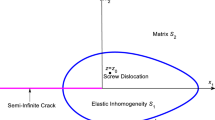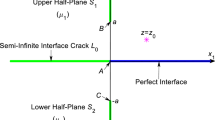Abstract
The interaction between a screw dislocation and a circular nano-inhomogeneity with a semi-infinite wedge crack penetrating the interface is investigated. By using Riemann-Schwartz’s symmetry principle integrated with the analysis of singularity of complex functions and the conformal mapping technique, the analytical expressions of the stress field in both the circular nano-inhomogeneity and the infinite matrix, the image force acting on the screw dislocation and the stress intensity factor at the crack tip are obtained. The influence of elastic mismatch of materials, inhomogeneity size, interface stress, wedge crack opening angle and the relative location of dislocation on the image force and on the equilibrium position of the screw dislocation and the shielding effect of the screw dislocation are discussed in detail. The results show that interface stress has a significant impact on the movement of dislocations near the interface, and the effect of interface stress enhances when the inhomogeneity radius decreases. With the decrease in the wedge crack opening angle, the influence of interface stress on the movement of the screw dislocation and on the SIF enhances. With the increment of the relative shear modulus, the influence of interface stress weakens with the screw dislocation locating in the inhomogeneity and strengthens with the screw dislocation locating in the matrix. When the screw dislocation is located in the inhomogeneity, the positive (negative) interface stress increases (decreases) the shielding effect, while this phenomenon is opposite when the screw dislocation locates in the matrix.
Similar content being viewed by others
References
Hirth J.P., Lothe J.: Theory of dislocations. Wiley, New York (1982)
Smith E.: The interaction between dislocations and inhomogeneities-1. Int. J. Eng. Sci. 6, 129–143 (1968)
Head A.K.: X. The interaction of dislocations and boundaries. Philos. Mag. 44, 92–94 (1953)
Gong S.X., Meguid S.A.: A screw dislocation interaction with an elastic elliptical inhomogeneity. Int. J. Eng. Sci. 32, 1221–1228 (1994)
Xiao Z.M., Chen B.J.: A screw dislocation interaction with a coated fiber. Mech. Mater. 32, 485–494 (2000)
Liu Y.W., Jiang C.P., Cheung Y.K.: A screw dislocation interacting with an interphase layer between a circular inhomogeneity and the matrix. Int. J. Eng. Sci. 41, 1883–1898 (2003)
Fang Q.H., Liu Y.W., Jin B., Wen P.H.: Interaction between a dislocation and a core–shell nanowire with interface effects. Int. J. Solids Struct. 46, 1539–1546 (2009)
Chen J.T., Chou K.H., Lee Y.T.: A novel method for solving the displacement and stress fields of an infinite domain with circular holes and/or inclusions subject to a screw dislocation. Acta. Mech. 218, 115–132 (2011)
Wang X., Zhou K.: Long-range interaction of a line dislocation with multiple multicoated inclusions of arbitrary shape. Acta. Mech. 224, 63–70 (2013)
Feng H., Fang Q.H., Liu Y.W., Jin B.: Image force and stability of a screw dislocation inside a coated cylindrical inhomogeneity with interface stresses. Acta. Mech. 220, 315–329 (2011)
Xiao Z.M., Chen B.J., Luo J.: A generalized screw dislocation near a wedge-shaped magnetoelectroelastic bi-material interface. Acta. Mech. 214, 261–273 (2010)
Zhou K., Wu M.S.: Elastic fields due to an edge dislocation in an isotropic film-substrate by the image method. Acta. Mech. 221, 271–292 (2010)
Hoh H.J., Xiao Z.M., Luo J.: On the plastic zone size and crack tip opening displacement of a Dugdale crack interacting with a circular inclusion. Acta. Mech. 210, 305314 (2010)
Zhang T.Y., Li J.C.M.: Image forces and shielding effects of an edge dislocation near a finite length crack. Acta. Metal. Mater. 39, 2739–2744 (1991)
Zhang T.Y., Li J.C.M.: Image forces and shielding effects of a screw dislocation near a finite-length crack. Mater. Sci. Eng. A. 142, 35–39 (1991)
Wu K. C.: Transient dislocation emission from a crack tip in an anisotropic elastic material. Acta. Mech. 224, 925–933 (2013)
Fan H., Xiao Z.M.: A Zener-Stroh crack near an interface. Int. J. Solids Struct. 34, 2829–2842 (1997)
Baker D.A., Bellare A., Pruitt L.: The effects of degree of cross linking on the fatigue crack initiation and propagation resistance of orthopedic-grade polyethylene. J. Biomed. Mater. Res. A. 66, 146–154 (2003)
Ouyang H., Sanboh L.: Screw dislocations near a crack penetrating through an interface. Eng. Fract. Mech. 54, 629–637 (1996)
Epstein M.: The Eshelby tensor and the theory of continuous distributions of inhomogeneities. Mech. Res. Commun. 29, 501–506 (1996)
Wang Y.P., Roberto B.: A long crack penetrating a circular inhomogeneity. Meccanica 38, 579–593 (2003)
Song H.P., Gao C.F.: The interaction between a screw dislocation and a rigid wedge inhomogeneity with an elastic circular inhomogeneity at the tip. Meccanica 47, 1097–1102 (2012)
Wang X., Pan E.: On a finite crack partially penetrating two circular inhomogeneities and some related problems. Appl. Math. Model. 36, 1766–1775 (2012)
Xiao W.S., Xie C.: A technique for studying interaction between a screw dislocation dipole or a concentrated load and a mode III crack crossing an interface. Int. J. Solids Struct. 45, 5705–5715 (2008)
Miller R.E., Shenoy V.B.: Size-dependent elastic properties of nanosized structural elements. Nanotechnology 11, 139–147 (2000)
Gurtin M.E., Murdoch A.I.: A continuum theory of elastic material surfaces. Arch. Ration. Mech. Anal. 57, 291–323 (1975)
Sharman P., Ganti S., Bhate N.: Effect of surfaces on the size-dependent elastic state of nano-inhomogeneities. Appl. Phys. Lett. 82, 535–537 (2003)
Muskhelishvili N.L.: Some basic problems of mathematical theory of elasticity. Noordhoff, Leyden (1975)
Chen B.J., Xiao Z.M., Liew K.M.: Electro-elastic stress analysis for a wedge-shaped crack interacting with a screw dislocation in piezoelectric solid. Int. J. Eng. Sci. 40, 621–635 (2002)
Shen M.H., Chen S.N., Lin C.P.: The interaction between a screw dislocation and a piezoelectric fiber composite with a wedge crack [J]. Arch. Appl. Mech. 82, 215–227 (2012)
Ohr S.M., Chang S.J., Thomson R.: Elastic interaction of a wedge crack with a screw dislocation. J. Appl. Phys. 57, 1839–1843 (1985)
Fang Q.H., Liu Y.W., Jin B., Wen P.H.: Interaction between a dislocation and a core-shell nanowire with interface effects. Int. J. Solids Struct. 46, 1539–1546 (2009)
Xie C., Liu Y.W., Fang Q.H., Deng M.: Cracking characteristics of mixed mode dislocations near a lip-like mode crack. Theor. Appl. Fract. Med. 51, 139–143 (2009)
Author information
Authors and Affiliations
Corresponding author
Rights and permissions
About this article
Cite this article
Zhang, Y.B., Fang, Q.H. & Liu, Y.W. The interaction between a screw dislocation and a nano-inhomogeneity with a semi-infinite wedge crack penetrating the interface. Acta Mech 225, 581–594 (2014). https://doi.org/10.1007/s00707-013-0978-z
Received:
Revised:
Published:
Issue Date:
DOI: https://doi.org/10.1007/s00707-013-0978-z




